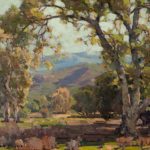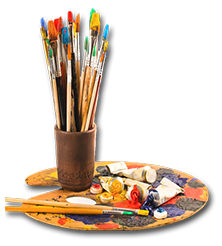Major Breakthroughs
Major Breakthroughs

Edgar Payne (1883-1947). Sycamores Near Santa Paula. Oil on canvas, 22 x 26 in.
The following spring they took Evelyn to see her maternal grandparents in San Francisco. They would also attend the Panama-Pacific International Exposition. The following year Edgar would make his first trip to the Sierra Nevada Mountains. This trip would again be a big moment in his life, and he would return again and again to paint the beauty of the unspoiled Sierra, these paintings would be one of his hallmarks.
He earned his first major commission in 1917. In a bid to attract tourist, the Atchison, Topeka and Santa Fe Railroad asked him to paint the Southwest, along the railroads’ trek from Albuquerque to California. This commission would solidify, not only his reputation as an artist, but it would also forever link him to Western America. Although he would paint in Europe, he is most remembered for his work from the Four Corners area, on the Navajo Nation Reservation, to that of Yosemite, and the California coast. That year He and Elsie would spend four months painting, exploring, and taking in Canyon de Chelly. This area, from Taos, New Mexico to the Grand Canyon, would become one of Payne’s two main inspirations for the next twenty years.
The Santa Fe Railroad commissions were the turn of the century brainchild of William H. Simpson, chief of the railway’s advertising department. Starting in 1892, with Thomas Moran, Simpson would exchange travel on the train, along with lodging at railroad hotels and meals at railroad restaurants, and even sometimes cash, for paintings, photographs, pottery, and jewelry. This endeavor would last for decades, make the Santa Fe one of the largest collectors of southwestern fine art, and most importantly, give America a valuable lasting treasure.
When the Santa Fe commission expired the couple returned to San Francisco. Edgar received a commission from the Congress Hotel in Chicago for a mural of 11,000 square yards of muslin. The mural would cover several floors of the hallways of the hotel. He would need to rent a warehouse in Glendale, California, and hire other artist to help him, including Elsie, to complete the work.
In 1918, Edgar and Elsie would make their home, with studio in Laguna Beach. He would organize a local art association, the Laguna Beach Art Association, and become its first president. They would spend the next four years painting their way throughout the southwest, and to places like Canadian Rockies in British Columbia, and Alberta, Canada, and then exhibiting in the Los Angeles area. Sometimes their trips would be hiking into the backcountry, looking for undisturbed places of raw, and rare beauty, to paint, sometimes for weeks. After finding success during this period, the trio took a two-year “painting tour” of Europe, 1922-1924. Painting in Brittany, Paris, Provence, Switzerland, and Venice. Of course his favorite place in Europe was the Alps, painting The Great White Peak of Mont Blanc, which in the spring of 1923, the Paris Salon gave “an honorable mention”.
“The Great White Peak” is reputed to be in the collection of Newport Harbor High School in Newport Beach, California. This painting, and others, formed a collection of annual acquisitions at an art show sponsored to acquaint high school students with styles of painting and art. The collection was forgotten and distributed to various offices (and closets)in the school district. Its existence was re-discovered by school librarian John McGinnis who tracked down and restored all 56 of the missing paintings. The collection is now known as the “The Ruth Stoever Fleming Collection”.
Upon returning the U.S. in the fall of 1924, they first stayed in Chicago, then back to Laguna Beach, and then on to New York City in 1926. Always on the go, they would move and paint in Arizona, California, the California Sierras, Connecticut, New Mexico, New York, and Utah. They would spend the summers crossing the country, painting as they went. They returned to Europe to paint the harbors of Brittany, and Chioggia, in 1928. The following summer they painted Lake Louise, Alberta.

